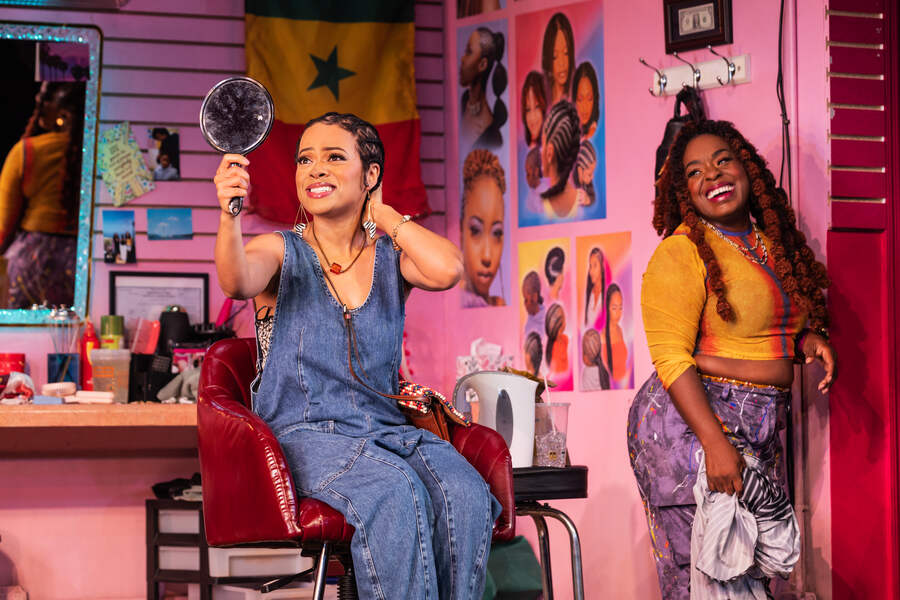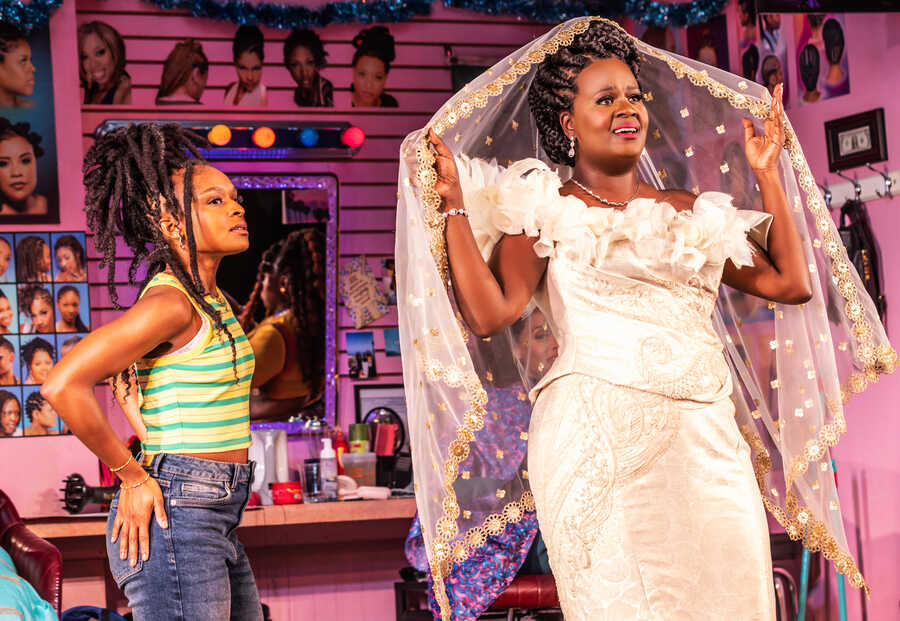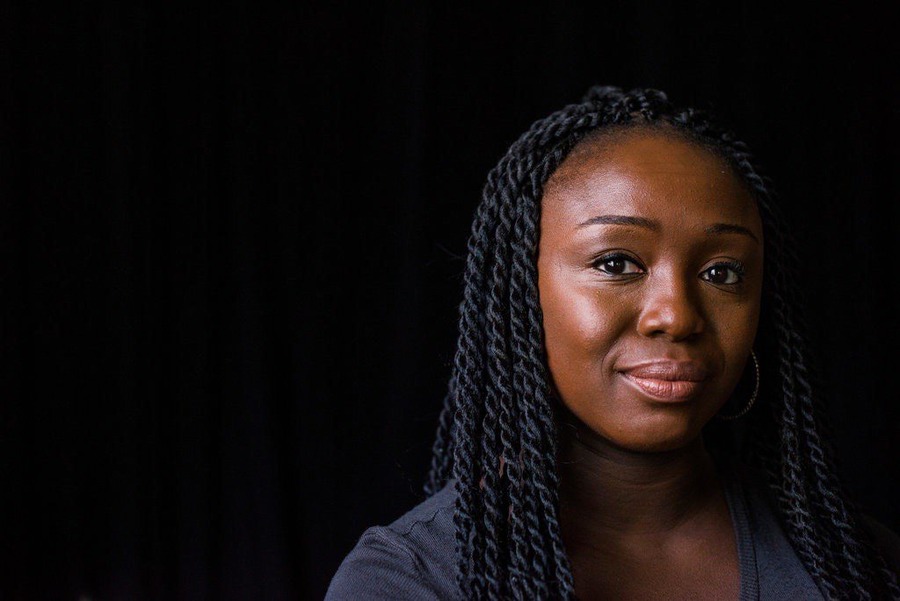The complete script of Jaja’s African Hair Braiding appears in Winter 2024 issue (subscribe here to receive a copy). Playwright Jocelyn Bioh spoke with Lynn Nottage (Pulitzer winner for Ruined and Sweat) about her process, her people, and her play’s success in its premiere last fall at Manhattan Theatre Club.
LYNN NOTTAGE: What a run you had! And what a joy to spend a day in your hair salon, with your humor and your compassion and your love of Black women! Congratulations. It was a triumphant debut on Broadway.
JOCELYN BIOH: Thank you so much. I can’t even articulate how much that means coming from you.
I’m so curious about your process. Something that I admire about your work is that the worlds are so specific. From School Girls to Nollywood Dreams to Jaja’s, there’s a real sense that your imagination has fully inhabited the spaces. By the end of Jaja, I felt like I was sitting in the salon chair for a full day, soaking in the full complexity of the women. I could actually feel my hair being tugged. The question I want to ask is, where do you begin your writing journey? With a place, with a character, or with an idea?
They all stem from different places, but for the most part, they come from characters. I’m always super curious about people. I watch a lot of reality shows, I watch a lot of documentaries, because I’m just so curious about people’s lives and how they live, what decisions they make that then impact the rest of their lives. I’m obsessed with the little quirks and nuances. For the most part, we all were born, we got some nutrients, we had somebody who took care of us—but then we all end up very different. We all see things differently. We are sensitive to different things. I’m fascinated by that, and when you put all those people in a room, what happens.
In the case of Jaja’s, there were very different personalities who come in and out of the shop daily. Obviously I have a ton of experience. I’m going to the hair braiding shop in three days; I’m there probably every six weeks, and have been at a hair braiding shop since I was, like, 4 or 5 years old. So I really, really know the shop, and I just thought this setting was very rich for a play.

It’s interesting listening to you talk about character, because one of the things that always strikes me in your work is that you create these beautiful ensembles where no one is the central character, but everyone is the central character. I don’t think people know how difficult that is, to keep all those balls juggling up in the air. I wonder if you can talk a little bit about why you gravitate to this sort of play, because I do as well.
Well, I get huge inspiration from you. Character is where I start, which is why I love doing big ensemble pieces; I’m also an actor, and I love when we are all working as a unit together to create a story. There’s something really powerful about when the story is the main character, or the place is the main character—and then you know how we all fill it in. It’s like this puzzle we’re all trying to put together every single night. It’s so satisfying when you put in that last piece, and it’s like, “End of Play.”
Also, I’m curious about Black women. I just think we are not centered enough in anything, and putting as many different kinds of Black women—there’s just a diaspora, especially with Jaja’s, from all walks of life, from all different countries and places. There’s something very thrilling about centering us in that way. I feel like sometimes when people see plays or movies or TV shows, they tend to really latch onto one person and put everything on that one character. I’m really trying to show the rich tapestry of who we are as women. Being able to put as many in a story as possible feels like a wonderful challenge. Sometimes it’s crazy. I mean, it’s 10 actors, 17 different characters—I was losing my mind just tracking everyone. But it’s really always about, how do I center and celebrate as many Black women as I can in a story?
The other thing that I really appreciate in your work is that it’s not concerned with the white gaze. There are multiple tensions in your plays; one is class tension. Then there’s the cultural tension between women who are from the continent and women who are in the diaspora, who don’t necessarily understand how to be in dialogue, but find ways eventually to do that, which I thought was really masterfully handled in Jaja’s. I wonder, how do you circumvent some of the tropes that have really imprisoned us as Black writers?
Whoa—big question. I feel like I circumvent them because I try my best to just not be concerned with them. At the end of the day, I think our plays are inviting an audience into a day in the life of this family, or the story of how this person overcame something, and those people live that story—as opposed to educating an audience on culture and nuances and what have you. I feel like I’m really done thinking about that. That was something I was really exploring in my earlier work, in grad school. Nobody ever is gonna see those plays; they’re locked away in a folder called “Taxes” or something. I was concerned about the white gaze, and it didn’t serve my work. Once I let that go and actually just concerned myself with who these people were, what kind of environment we were in—in the case of Jaja’s, really centering the women in the shop—I feel like the more I dig in with the specificity of the place, the people, the time, it unlocks a weird universality. So the audience doesn’t actually feel othered in any way; they almost feel like they’ve been inside with them, and they connect to the characters. They’re like, “Oh, this is like my mother or my sister,” whomever. It’s very odd sometimes how that happens—where people really see themselves, even if they’re very opposite from the people in the play.
I do think that it feels very universal. All those characters are familiar, regardless of where you’re from. The fact that the women are entrepreneurial, competitive, duplicitous, aspirational, territorial but ultimately community-minded, is something that feels universal. I mean, it’s all there. Just to pivot: I’m curious, was there anything that surprised you about bringing Jaja’s to Broadway?
That we were doing it on Broadway! That has been the biggest surprise of my life. I’m an Off-Broadway girlie. Everything I’ve done, for the most part, as an actor and a writer, has been in the safe confines of the Off-Broadway space. Broadway, as you know, just shifts things—there’s just a different something that people look for in your work. Particularly if you’re debuting a play on Broadway, which has been very rare, I started to have a real fear that people were gonna come in with their arms crossed, like, “This better impress me, because how the hell is it opening on Broadway cold?” So I worked hard, but not any differently than I would have if we were opening the play at some Off-Broadway space.
I think the second surprise was the way the community showed up. So often, in any medium, we’re told, “Oh, these shows don’t sell,” or, “It’s hard to get the audience”—whatever excuse people can throw at something for why it doesn’t work or isn’t successful. From the very first preview, the community showed up for the whole run. I was so surprised, but it was a pleasant surprise, because I had a lot of faith that the work we were doing in terms of marketing was going to pay off. I was really very moved—I still am—at the way they showed up and were like, “We’re gonna support this play. This is a play about us on Broadway, and we’re going to support it.” I’ll never forget it. It was a surprise.

I have a question that’s related to that. I know that you were negotiating two very different audiences on Broadway: the audience who subscribes to Manhattan Theatre Club that sits very quietly, applauds politely, goes and has a cocktail, and an audience that has a very different tradition of engaging with entertainment that is more responsive. As the playwright, how did you find the balance of serving one audience and serving the needs of another audience?
This time around I said, I’m not concerned with the subscribers. I appreciate them; I’m so glad that they’re there. But I said, I’m not gonna concern myself with the subscribers. I’m concerned about finding that new first-time ticket buyer—I want to hear a bunch of people from Harlem who go to the hair braiding shop all the time say, “Oh my God, I love Jaja’s, this was my first Broadway show.” We also found an affordable ticket price that would be available throughout the run of the show, even the extension. That’s why those subway ads had those discount codes on them; people just had to act early. And then we had a live stream option available for the last week, which you know, because Clyde’s also had the live stream.
It was the first live-streamed Broadway show. But we had to do it out of necessity—our show went up in the middle of COVID. There was a surge and we thought, what are we going to do? How are we going to find our audience? When we streamed, we found that we were selling out our shows, because people still wanted to see it. I’m curious, why did you choose to stream, and what did you discover in the process of streaming?
I said in one meeting, “This is an international show. This is a show that anyone around the world who has any sort of connection to a shop or a space like this is going to feel connected to and really enjoy.” That unlocked something for MTC, and they ended up signing on with the League of Live Stream Theater, who did yours as well. I’m just so appreciative that that kind of company even exists, and I’m so glad that was available to us. I actually just got the breakdowns of who all streamed the show, and there were tickets bought in Tanzania, in South Africa, in Rwanda.
I had friends who had never seen my work who could see my plays for the first time.
My mother lives in Ghana, and she was able to watch the show from her little computer. That is a thing that we never really thought until necessity called for it, but I’m so glad it’s something that exists. Accessibility in theatres is the truth, the light, and the way.


